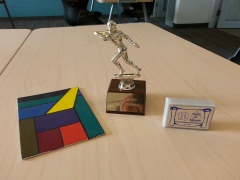Sometimes when I’m out running, especially along the stretch of bike trail that is closely flanked by forest on one side and a thirty-foot high wall on the other, I’ll pass a woman and wonder if my presence causes her any concern. Do I appear threatening? Does she grip a little more tightly a concealed container of mace or review the self-defense tips she learned from her sensei?
I like to think that I don’t inspire fear, that my smile (forced as it is when I’m running) is one of encouragement and not lascivious deviance. But here’s the thing: it’s not up to me. Ultimately, she is going to think what she is going to think and all I can do is keep running (and definitely not wink or compliment the gracefulness of her stride).
This past year I realized something: students see me the same way and I have little control over it. In a new building this year, students will know nothing about me except that I’m a teacher (and even that simple fact is open to diverse interpretation).
In the past, I’ve fed classes quick autobiographical sketches filled with tidbits of information that were meant to humanize me and demonstrate my professionalism. These introductions included facts like these (with the implied message in parentheses):
- I am married and have three kids (Someone loves me).
- I’ve taught now for X years (I have experience and you should respect that).
- I have published blah, blah, blah (Bow, suckers, in the face of genius).
- My name is pronounced sker, as in, “Don’t be sker” (Don’t worry, I can also be cool and speak just like you!).
- I’m scared of swans, whales, and emus (I’m so crazy—you’ll just love me when you get to know more things about me like that).
This year I will say nothing about myself. I will let my life speak for me and allow the students to share their own perceptions. I have compiled a set of artifacts and primary documents from my past, which includes:
- My birth certificate, marriage certificate, and the certificate from my college dorm where I was voted Most Laid Back.
- A magazine with an article I wrote, but also a stack of rejections, including one that complimented my use of “poop jokes.”
- My own IEP from when I needed speech therapy, the result of a cleft palate (a letter from the Cleft Palate Clinic is included)
Much like any primary source document analysis, students need to study each piece to see what they can learn (will anyone notice that the minister who performed my wedding shares the last name of my wife? and will they correctly infer that it is her father? or that my wife was born in the Philippines?) So instead of me talking about myself with nobody listening, students are actively involved. The benefits as I see them:
- Instead of students silently judging me, I get to hear what they think (do they seem impressed by my publications or put off?) and I can respond accordingly.
- Not only do I learn about what they think of me, I get a glimpse into how they think. How keen are their powers of observation? How well can they infer and how willing are they to speculate? Do they synthesize what they learn from different information?
- And lastly, who knows, maybe I’ll even learn something about myself.


Aug 22, 2013 @ 03:33:16
I love this idea, Greg. It gets them thinking about claims and evidence right away. I’d love to be a fly on the wall and hear their comments.
Aug 22, 2013 @ 12:43:35
Thanks, Erica. I’ll keep you posted with how it went.
Aug 24, 2013 @ 14:12:52
Thanks for sharing Greg. I am going to try some aspects of your idea – let me know how it goes for you. I usually do an exercise on stereotypes when I introduce myself – they have to make educated guesses about me based on my room and how I present myself – it is a 15 questions. When I reveal the answers, I ask for their answers and reward those who are closest to the truth – I also ask who in the class wants to share their answer about themselves. This is the prelude to their own activity in which they share themselves with us called picture me poem.
Good luck! Please share the results!
Aug 25, 2013 @ 12:15:32
Sounds interesting. I think it’s important we recognize our own biases and prejudices so we can shine a light on and analyze them.